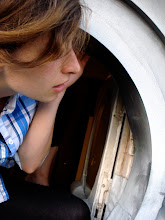So I wait until the summer to make a list. I know it's the right time to do so when the sun is shining clearly in my face and I've got a (somewhat) blank slate after Spring semester. I also keep my resolutions modest, so that I don't have to defy my biology or mental capacity to undertake them. Cheating the system? You bet.
So here they are:
1) Read some good books
2) Hike some beautiful hills
3) Make more salads

Salads saved me during finals and the days leading up to my move out of the quaint Berkeley apartment that I called home. During this time, my lovely and insightful aunt sent me a brief e-mail entitled "Exams" and wrote one of the most useful sentences I've ever encountered: "Take a walk in the sunshine (or a run) and make a great big salad with all kinds of yummy fresh things and some nuts. Take a deep breath. Smile and enjoy the pleasure of learning."
So I set to work (on the salads, walks, and runs that is). My staple was a salad with radishes (which are oh-so-good and 99 cents a bunch!), celery, lettuce, and cucumbers, with tofu instead of nuts. Then, when it came time to empty out the remaining ingredients that had been hiding in the cupboards of the kitchen, I concocted a salad with quinoa, a can of black-eyed peas, and some frozen green peas.
Aside from academic pursuits and the job hunt, I think this is going to be a good summer- especially if there are salads involved :)
PS- promising a more stream of consciousness post next week. For now- simplicity is the name of the game. Sorry to bore.

Summer Quinoa Salad
This time around, I shelled peas (which is quite relaxing) and blanched them. Otherwise, this recipe is geared towards frozen peas.
1 cup quinoa, rinsed
1 can black eyed peas, drained and rinsed
1 cup frozen peas, thawed
2 tbs chopped parsley
1 tbs. good quality olive oil (I swear by the Spanish stuff)
1 tbs. lemon juice (or juice of 1/2 lemon)
1 scant tbs. chardonnay or white wine vinegar (really any kind is fine here)
Heat the quinoa with 2 cups water over a high flame until the mixture is boiling. Then lower the heat, cover, and cook for 10-15 minutes. The quinoa will be done when the grains have expanded and little curly q's have formed around their edges (you'll know what I mean!) Qunioa cooks pretty quickly, so keep an eye on it. When done, put aside in a bowl to cool.
When the mixture is still warm but not steaming hot, mix in the black eyed and green peas. Then add the parsley, olive oil, lemon, and vinegar, adding salt and pepper to taste. You can eat it like that, but I'd recommend putting it in the fridge for a couple of hours and enjoying it cold- preferably with a beer and a rooftop view.
Bon appetit!
1 can black eyed peas, drained and rinsed
1 cup frozen peas, thawed
2 tbs chopped parsley
1 tbs. good quality olive oil (I swear by the Spanish stuff)
1 tbs. lemon juice (or juice of 1/2 lemon)
1 scant tbs. chardonnay or white wine vinegar (really any kind is fine here)
Heat the quinoa with 2 cups water over a high flame until the mixture is boiling. Then lower the heat, cover, and cook for 10-15 minutes. The quinoa will be done when the grains have expanded and little curly q's have formed around their edges (you'll know what I mean!) Qunioa cooks pretty quickly, so keep an eye on it. When done, put aside in a bowl to cool.
When the mixture is still warm but not steaming hot, mix in the black eyed and green peas. Then add the parsley, olive oil, lemon, and vinegar, adding salt and pepper to taste. You can eat it like that, but I'd recommend putting it in the fridge for a couple of hours and enjoying it cold- preferably with a beer and a rooftop view.
Bon appetit!





